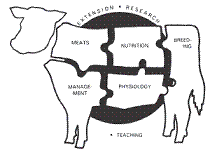Animal Science, Department of

Nebraska Beef Cattle Reports
Date of this Version
2021
Citation
Published in 2021 Nebraska Beef Cattle Report, University of Nebraska Extension Publication MP110
Abstract
Forage samples from Nebraska and South Dakota submitted to Ward Laboratories, Inc. from 2012– 2019 were analyzed for mineral concentrations. Samples were categorized by forage species, quality based on protein content, and mineral concentration based on requirements for lactating beef cows. ! e data indicate that copper and zinc are frequently deficient across all species and levels of forage quality, emphasizing the need for supplementation. Except for magnesium, macro- mineral deficiencies are less likely to occur when feeding high quality forages in Nebraska and South Dakota. Corn feedstuffs are particularly likely to result in mineral deficiencies if fed without mineral supplementation. High protein annual small grain forages are more likely to have high tetany ratios than other forages. Forage mineral analysis can assist in determining whether or not supplementation is required and at what level. Forage mineral analyses is one component of developing a livestock mineral management strategy, in conjunction with livestock health and performance records, and overall ranch goals.
Included in
Large or Food Animal and Equine Medicine Commons, Meat Science Commons, Veterinary Preventive Medicine, Epidemiology, and Public Health Commons


Comments
Copyright © 2020 The Board of Regents of the University of Nebraska.